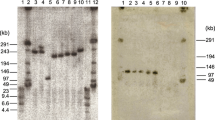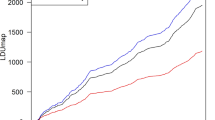Abstract
Based on selective silver nitrate staining of active ribosomal gene (AcRG) clusters in nucleolus organizer regions (NORs) of human metaphase chromosomes, a technique was developed earlier to estimate the AcRG dosage in individual genomes as a sum of arbitrary units (0–3) ascribed to the silver precipitate (AgNOR) on ten NORs. The AcRG dosage was considered to be an additive quantitative trait determined by five polymorphic autosomal loci (with four allelic forms for each locus). A database was created to contain the data on AcRG cluster variants for more than 1000 individual human genomes. In this study, the population frequencies of AcRG cluster variants were determined. The results agreed with the hypothesis that stabilizing selection acts at the zygotic and/or early embryogenetic stage to restrain the AcRG genomic dosage (copy number) within a range from 14.9 to 23.7 arbitrary units (the cell is unviable when the trait is beyond this range). The average zygotic losses due to selection were estimated at 9.1–9.9% for a real population. A computer model where the AcRG dosage of a progeny results from a random combination of the AgNORs of the five acrocentric chromosome pairs of the parents was developed and used to simulate the formation of a certain AcRG genomic dosage through generations in a human panmictic population with nonoverlapping generations. A combination of stabilizing selection by total AcRG copy number and a certain spontaneous mutation rate (the probability of changes in the cluster size of a NOR as a result of unequal crossingover in meiotic prophase) was shown to be a sufficient condition for the restrain of equilibrium population frequencies of AgNOR size variants in a human panmictic population. Using the model, the most probable spontaneous mutation frequency was predicted to be (2.1–2.3) × 10−2 per NOR per generation for human AgNORs. The predicted frequency was within the 95% confidence interval of the experimental rate, which was determined by studying the inheritance of AgNOR variants in real families.
Similar content being viewed by others
References
Veiko, N.N., Egolina, N.A., Radzivil, G.G., et al., Quantitation of Repetitive Sequences in Human Genomic DNA and Detection of an Elevated Ribosomal Repeat Copy Number in Schizophrenia: The Results of Molecular and Cytogenetic Analyses, Mol. Biol. (Moscow), 2003, vol. 37, no. 3, pp. 349–357.
Lyapunova, N.A. and Veiko, N.N., Ribosomal Genes in the Human Genome: Identification of Four Fractions, Their Organization in the Nucleolus and Metaphase Chromosomes, Russ. J. Genet., 2010, vol. 46, no. 9, pp. 1070–1073.
Bloom, S.E. and Goodpasture, C., An Improved Technique for Selective Silver Staining of Nucleolar Organizer Regions, Hum. Genet., 1976, vol. 34, pp. 199–206.
Howell, W.M. and Black, D.A., Controlled Silver-Staining of Nucleolus Organizer Regions with a Protective Colloidal Developer: A 1-Step Method, Experientia, 1980, vol. 36, pp. 1014–1015.
Miller, D.A., Dev, Y.G., Tantravahi, R., and Miller, O.J., Expression of Human Nucleolus Organizer Activity in Mouse-Human Somatic Hybrid Cells, Exp. Cell Res., 1976, vol. 101, pp. 235–243.
Hubbell, H.R., Silver Staining as an Indicator of Active Ribosomal Genes, Stain Technol., 1985, vol. 60, no. 5, pp. 285–294.
Lyapunova, N.A., Kravets-Mandron, I.A., and Tsvetkova, T.G., Cytogenetics of the Nucleolus Organizer Regions (NORs) of Human Chromosomes: The Identification, Individual Variation, and Chromosome Distribution of four Morphological Functional Variants of NORs, Russ. J. Genet., 1998, vol. 34, no. 9, pp. 1095–1102.
Lyapunova, N.A., Egolina, N.A., Tsvetkova, T.G., et al., Cytogenetics of the Nucleolus Organizer Regions (NORs) of Human Chromosomes: Results of Molecular and Cytogenetic Analyses, Biol. Membrany Kletki, 2001, vol. 18, no. 3, pp. 189–199.
Veiko, N.N., Terekhov, S.M., Shubaeva, N. O., et al., Early and Late Responses to Oxidative Stress in Human Dermal Fibroblasts of Healthy Donors and Rheumatoid Arthritis Patients: Relationship between the Cell Death Rate and the Genomic Dosage of Active Ribosomal Genes, Mol. Biol. (Moscow), 2005, vol. 39, no. 2, pp. 234–243.
Sozanskii, O.A. and Terekhov, S.M., Comparative Study of Nucleolus Organizer Chromosomes’ Activity in Human Blood Lymphocytes and Skin Fibroblasts, Byull. Eksp. Biol. Med., 1983, vol. 95, no. 6, pp. 101–103.
Markovic, V.D., Worton, R.G., and Berg, J.M., Evidence for Inheritance of Silver-Stained Nucleolus Organizer Regions, Hum. Genet., 1978, vol. 41, pp. 181–187.
Taylor, E.F. and Martin-Deleon, P.A., Familial Silver Staining Patterns of Human Nucleolus Organizer Regions (NORs), Am. J. Hum. Genet., 1981, vol. 33, pp. 67–76.
Lyapunova, N.A., Egolina, N.A., and Viktorov, V.V., Patterns of the Inheritance of Polymorphic Variants of Nucleolus Organizer Regions of Human Chromosomes, in Khromosomy cheloveka v norme i patologii (Human Chromosomes in Norm and Pathology), Moscow: Nauka, 1989, pp. 12–20.
Veiko, N.N., Lyapunova, N.A., Bogush, A.I., et al., Ribosomal Gene Number in Individual Human Genomes: Data from Comparative Molecular and Cytogenetic Analysis, Mol. Boil. (Moscow), 1996, vol. 30, no. 5, pp. 1076–1085.
Veiko, N.N., Structural and Functional Organization of Human Ribosomal Repeats, Doctoral (Biol.) Dissertation, Moscow: Moscow State Sci. Center Russ. Acad. Med. Sci., 2001, p. 258.
Lakin, G.F., Biometriya (Biometry), Moscow: Vysshaya shkola, 1990.
Zaks, L., Statisticheskoe otsenivanie (Statistical Evaluation), Moscow: Statistica, 1976.
Stults, D.M., Killen, M.W., Rierse, H.H., and Rierse, A.J., Genomic Architecture and Inheritance of Human Ribosomal RNA Gene Clusters, Genome Res., 2008, vol. 18, no. 1, pp. 13–18, http://www.ncbi.nlm.nih.gov/pmc/articles/PMC2134781/
Author information
Authors and Affiliations
Corresponding author
Additional information
Original Russian Text © L.N. Porokhovnik, V.V. Viktorov, N.A. Egolina, T.G. Tsvetkova, N.A. Lyapunova, 2011, published in Genetika, 2011, Vol. 47, No.12, pp. 1666–1675.
Rights and permissions
About this article
Cite this article
Porokhovnik, L.N., Viktorov, V.V., Egolina, N.A. et al. Cluster size polymorphism of active human ribosomal genes and simulation of the conditions of its stability through generations. Russ J Genet 47, 1479–1486 (2011). https://doi.org/10.1134/S1022795411120106
Received:
Published:
Issue Date:
DOI: https://doi.org/10.1134/S1022795411120106




